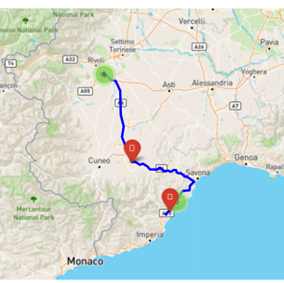Optimal controls with cloud-based user-centric predictive algorithms for Battery Electric Vehicles
The vehicle validator is based on a new Fiat 500e High Range with DC fast charge functionality. The vehicle has been modified introducing a dedicated hardware and software architecture allowing a bidirectional communication cloud-vehicle. The scope of the validator is to evaluate in real use the effectiveness of different cloud based functions developed in CEVOLVER and quantify the end user benefits knowing the optimal route also in consideration of the weather influence.
Three main goals are pursued:
- HV battery thermal preconditioning before the DC fast charge (preheating or precooling depending on the battery temperature) with the aim to minimize the charging time but respecting the target vehicle range and its battery life time.
- Eco-driving functionality in terms of target speed suggestions to the driver by means of a dedicated HMI. The optimal target speed definition is based on the information coming from navigator and eco-driving algorithm.
- Eco-charging as combined eco-routing and charge-stop planning to minimize the overall trip duration by cloud computing.

The planning of the charge-stop along the trip (eco-charging) has a positive impact on the total trip time, which is normally higher than the one of a conventional ICE vehicle due to the long charging stops. The expected saved time for the DC fast charge is up to 50% (on a long trip and in the middle season), making more acceptable a long trip with a BEV vehicle for the user.

In order to understand the importance of the battery thermal preconditioning, keep in mind that the battery temperature to perform a fast recharge has to be inside a specific temperature window. The preconditioning functionality has the scope to bring the battery at the best temperature before to start the fast charge avoiding an extra time to do it after having connected the vehicle to the charging station before the fast charge phase. The function has been tested on the itinerary shown in the right figure. The pre-heating has a particularly relevant impact on cold climate. For instance, at -10°C it is expected a reduction of up to 60% of the complete DC fast charge time operation.